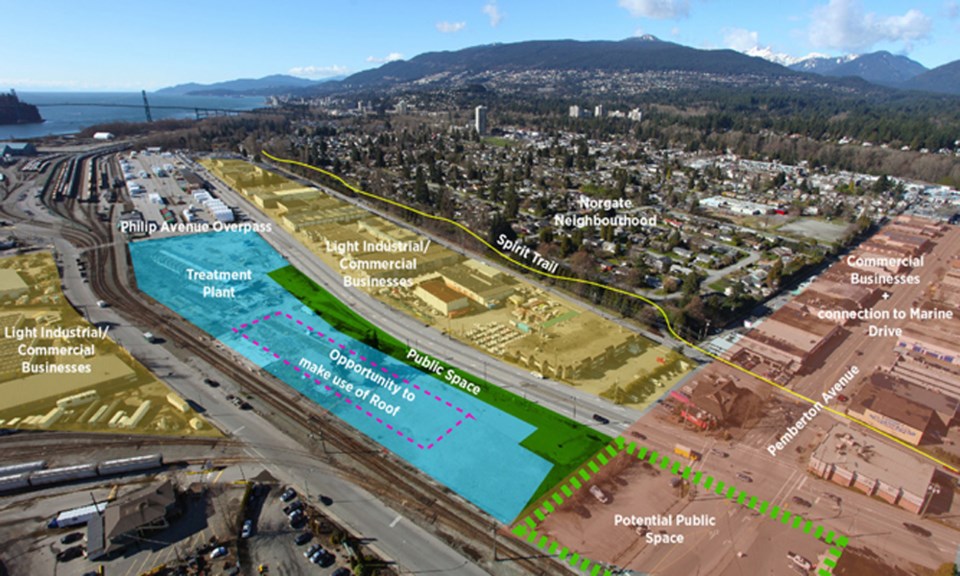Wastewater? Want not.
The provincial government pledged $193 million toward the new $700-million Lions Gate Wastewater Treatment Plant Saturday.
The amount – which leaves the North Shore paying about $147 million – is a bit less than the North Shore mayors had hoped for and the announcement was a bit later than anticipated but City of North Vancouver Mayor Darrell Mussatto said he was “thrilled.”
“Very soon you’ll start to see shovels in the ground,” said Mussatto, who also serves as chairman of the Metro Vancouver utilities committee. “There’s no way that the North Shore could have done it on our own.”
The plant will create jobs and be an economic boon, according to Minister of Community Peter Fassbender.
The North Shore mayors had advocated for an even split between the federal government, the province and the municipalities, putting everyone’s tab at about $233 million.
Given that the plant’s previous cost was projected to be $420 million, the price tag was never going to be split into perfect thirds, noted District of North Vancouver Mayor Richard Walton.
“When you’re dealing with three levels of government on different timelines, you’re never going to find that there’s an open-ended commitment from all three levels,” he said, crediting Mussatto for working on the project since both mayors were elected.
“It’s not the exact same as they said but it’s in the same ballpark,” Mussatto said.
With the province’s pledge as well as $212 million already committed by the federal government, building contracts will be announced soon, according to Mussatto.
In order to abide by federal regulations, the new plant must be operational by New Year’s Eve, 2020.
Under the agreement with Metro Vancouver, approximately $147 million will be divided throughout the region. That cost – which pays for the effluent pipeline and the secondary stage of sewage treatment – will be borrowed and paid back largely through sewer levies.
“The hit will be felt on the local utilities bill,” confirmed Kelly Sinoski with Metro Vancouver.
The remaining $147 million will be borne by the North Shore.
Mussatto described the payment plan as a “middle ground.”
“We’ll be paying more than what Vancouver or Surrey will be paying but when Vancouver has to do Iona (Island Wastewater Treatment Plant) they’ll be paying more,” he said. “At the end of the day it pretty much works out that each municipality is paying their fair share.”
The announcement allows the decommissioning of the 56-year-old sewage treatment plant on Bridge Road in Squamish Nation land. The new wasteland is slated to be wedged between McKeen Avenue and West First Street close to Pemberton Avenue in the District of North Vancouver.
The Bridge Road facility has been repeatedly expanded since opening in 1961, enabling it to handle more than 30-billion litres of wastewater annually, discharging treated wastewater into Burrard Inlet.
While not “highest on the political radar,” the treated wastewater released under the Lions Gate Bridge has always been a concern, Walton said.
The new plant is designed to use ultraviolet light and a chemical compound similar to household bleach to take 90 per cent of dissolved substances out of the water. The current treatment removes between 30 and 40 per cent of dissolved material.
While biogas will be produced at the plant, an air filtration system is designed to keep bad smells from escaping.
“Odour recovery is critical,” said Mussatto, noting the proximity of District of North Vancouver land and Squamish territory.
With a lot of shower water going down the pipes the wastewater tends to flow into the plant “at a pretty high temperature,” according to Mussatto.
That heat could be recovered and used as an energy source, he noted.
The plant is also designed to allow for phosphorus recovery.
The element – crucial in agriculture – is primarily mined from reserves in Morocco.
“There’s a limited supply and we’re slowly depleting that supply,” Mussatto said.
However, UBC professor Dan Mavinic has designed a reactor that alters the PH balance of wastewater and extracts pellets of phosphorus smaller than jelly beans that can be used to fertilize plants.
It’s still cheaper to buy phosphorus than to extract it but that may change, according to Mussatto.
“When it becomes economically viable we’ll be right in on it.”
The plant is designed to accommodate a population of 200,000 and leaves room for expansion. The North Shore’s current population is 180,000.



